Carrigbyrne Cheeses
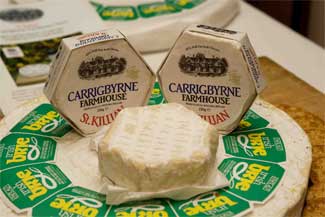 Carrigbyrne St Killian is one of Ireland’s longest-established and most popular farmhouse cheeses – easily recognisable (even when sold as an own-brand, eg M&S) by its presentation in a smart hexagonal box, this camembert style cheese has been made since 1982 by dairy farmers Patrick and Juliet Berridge on their family farm close to Adamstown in Co. Wexford, along with their other cheeses, St Brendans and Irish Brie.
Carrigbyrne St Killian is one of Ireland’s longest-established and most popular farmhouse cheeses – easily recognisable (even when sold as an own-brand, eg M&S) by its presentation in a smart hexagonal box, this camembert style cheese has been made since 1982 by dairy farmers Patrick and Juliet Berridge on their family farm close to Adamstown in Co. Wexford, along with their other cheeses, St Brendans and Irish Brie.
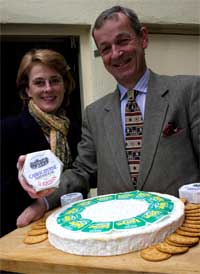 When young St Killian is firm and light-flavoured, but when you cut through the smooth white rind of a well-matured cheese, a rich creamy paste spills out, full of all the delicious grassy, light flavours of the sunny south-east. Consistent quality and regular supply make Carrigbyrne one of the most widely available Irish farmhouse cheeses - always on sale in specialist shops and in Tesco, Dunnes, Superquinn, Supervalue, M&S, and Waitrose in the UK and also Metro in Germany - one of their greatest areas of growth.
When young St Killian is firm and light-flavoured, but when you cut through the smooth white rind of a well-matured cheese, a rich creamy paste spills out, full of all the delicious grassy, light flavours of the sunny south-east. Consistent quality and regular supply make Carrigbyrne one of the most widely available Irish farmhouse cheeses - always on sale in specialist shops and in Tesco, Dunnes, Superquinn, Supervalue, M&S, and Waitrose in the UK and also Metro in Germany - one of their greatest areas of growth.
The Berridges (together with French cheesemaker Alain Girod, who joined them 1986) have won regularly at Irish, British and international cheese competitions since the mid-80s, including taking the Best Irish Cheese at the 2007 World Cheese Awards – and a 2009 Irish Food Writers Guild Award of Excellence.
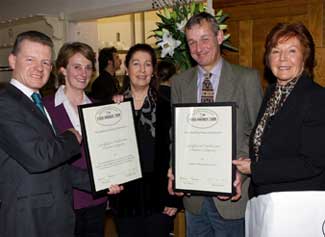 Carrigbyrne is also known for various recycling and other environmentally exciting projects – the reason for a second Irish Food Writers Guild Award, given ‘to acknowledge Irish food producers whose production process has succeeded in having a positive environmental impact on one or more of the following areas: water, waste, energy, by-products and packaging.’ The Berridges were the first winners of this new Environmental Award, and the number and variety of environmentally-friendly initiatives practised by them is astonishing.
Carrigbyrne is also known for various recycling and other environmentally exciting projects – the reason for a second Irish Food Writers Guild Award, given ‘to acknowledge Irish food producers whose production process has succeeded in having a positive environmental impact on one or more of the following areas: water, waste, energy, by-products and packaging.’ The Berridges were the first winners of this new Environmental Award, and the number and variety of environmentally-friendly initiatives practised by them is astonishing.
An early and enthusiastic champion of protecting the environment, Patrick installed an anaerobic digestor 12 years ago, designed to take slurry from the dairy farm and waste from the cheese plant. Bacteria converts organic matter to methane which can be used for heat power and even transport fuel. It produces 450 cubic metres of biogas every day, running an old two-cylinder engine which generates electricity. The compost is spread on the farmland. With Celtic Compost, they plan a unit for food waste and anticipate selling electricity back through the grid. Patrick is also involved in processing forest-thinnings into chips for central heating for local hotels.
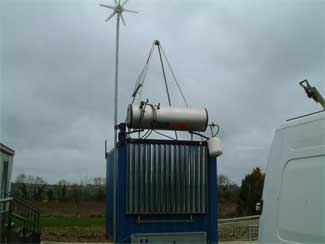 A member of the local Leader Renewable Energy Group, Patrick has also designed a travelling Eco-Cabin - an Aladdin’s cave of tricks made from environmentally-friendly bits and bobs, it’s a project for youngsters to have fun and develop an interest in renewable energy. A little windmill generates 36 watts, powering long-life bulbs, TVs and charging mobile phones. An 80 watt flat screen solar panel and a traditional solar panel heat water for a 200 litre water tank. The cabin also has a sun oven to cook meals and even a model car powered by hydrogen produced from water. As you’d expect, this imaginative educational project is welcomed with excitement when it arrives in a Wexford schoolyard!!
A member of the local Leader Renewable Energy Group, Patrick has also designed a travelling Eco-Cabin - an Aladdin’s cave of tricks made from environmentally-friendly bits and bobs, it’s a project for youngsters to have fun and develop an interest in renewable energy. A little windmill generates 36 watts, powering long-life bulbs, TVs and charging mobile phones. An 80 watt flat screen solar panel and a traditional solar panel heat water for a 200 litre water tank. The cabin also has a sun oven to cook meals and even a model car powered by hydrogen produced from water. As you’d expect, this imaginative educational project is welcomed with excitement when it arrives in a Wexford schoolyard!!
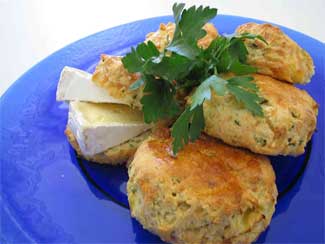 RECIPE: Camembert, Apple & Chive Scones
RECIPE: Camembert, Apple & Chive Scones
Savoury cheese scones are a delicious way of using up oddments of cheese – grated hard cheese is more usual but other cheeses including camembert/brie styles can be used, remembering that the proportion should be about half fat to flour. They may not rise as high as standard scones, but will be very tasty and nutritious served simply with a bowl of home-made soup.
Click here for recipe





There are currently no comments
Leave a comment
Not a member? Register for your free membership now!
Or leave a comment by logging in with: